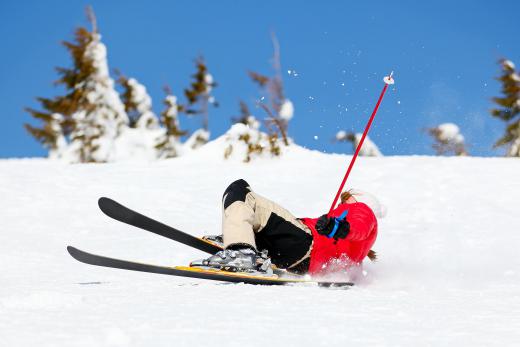Generally speaking, a ski lift is a structure that carries passengers up a mountain so that they can ski down. A common and simple type of ski lift is essentially a series of benches spaced apart and attached to a cable system. The cables are held up by long poles, which lift the cable and the benches off the ground. At either end of the cable system is a mechanism that turns in a single direction, keeping the chairlift constantly revolving in circles. Skiers hop on to one of the benches as it slowly passes, are carried to another point higher on the mountain, and hop back off as the chairlift continues on. The benches or chairs of a ski lift may be made for one person, or multiple people.
However, skiers are not the only ski lift users, and similar systems of transport are used in areas other than snowy mountain slopes. In fact, ski lifts and similar apparatuses can be considered as one of three different types. These are aerial lifts, surface lifts, and cable railways. Each of these types of ski lifts includes either a cable, rope, or rail to which are attached some kind of mechanism for carrying or pulling passengers along. Most types of ski lifts move in slow revolution along their route and do not change direction.

Aerial lifts are those ski lifts, either open or closed, which lift the passengers high off the ground. Types of aerial lifts include chairlifts and detachable chairlifts, which are usually open. Other types of aerial lifts with enclosed mechanisms for carrying passengers which are known as gondolas. Depending on the design and the arrangement of cables and gondolas, these type of lifts may be named aerial tramways, gondola lifts, and funitels, or funifors.

Another type of ski lift all together is the surface lift. Surface lifts are pulley systems which work similarly to aerial lifts, with the exception that they do not lift passengers off the ground. These structures are more simple and have largely been replaced by aerial lifts. Different types of surface lifts include T-bars and J-bars. As their names suggest, these are simply bars that the passenger grabs onto, and via the moving cable, is pulled up the slope of a mountain.

Another type of surface ski lift is called a magic carpet, which is like a conveyor belt that passengers step onto, and are carried along the route. In general, surface ski lifts are used across shorter distances, and up gradual inclines. This is due largely to the fact that if the passenger lets go of the rope or bar, he or she will slide back down the hill, possibly obstructing oncoming passengers and causing injury.
An entire network of ski lifts, perhaps of more than one type, may be used over a range of mountain terrain. The type of ski lift used, and the arrangement of the network, depends largely on the topography of the mountain, and also upon such things as the typical weather conditions found on the slopes. More than one set of lifts may have the same starting point or destination.
In cases where one particular summit is subject to high volumes of visitors, lifts may be multi-tiered in order to deliver more people at once to the end destination. Some ski areas have lifts which cross each other, though this is not common as it increases the risk of collision between one set of passengers and another. In addition, crossing sets of ski lifts present the risk of one falling on the other, creating twice the damage to the lift itself.
